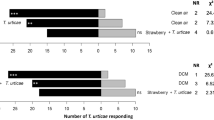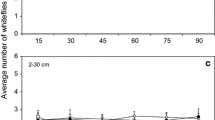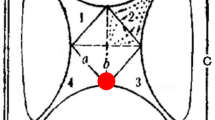Abstract
The olfactorial response of the fungivorous soil collembolanOnychiurus armatus was examined in a bioassay covering volatile compounds identified in the odor blends of two of its preferred fungal speciesMonierella isabellina andVerticillium bulbillosum. The odor of the fungi was trapped using activated carbon filters, extracted with diethyl ether, and subjected to GC-MS analysis. About 50% of the compounds resolved by GC were identified by a combination of electron impact and chemical ionization mass spectrometry. In a Y-shaped olfactometer the collembolans were attracted to a variety of common odors, such as CO2 and 2-methyl-1-propanol, and a species-specific odor, such as 1-heptene, and arrested by, for example, decanal and 2-octene. The response was not improved by pairwise combinations of common and specific odors. An amount of 0.5 ng of ethyl acetate or 3 pg of 1-pentanol was sufficient to attract the collembolans. The specific compounds ofV. bulbillosum, 1-heptene and 1-octen-3-ol, may be key stimuli explaining whyO. armatus prefersV. bulbillosum.
Similar content being viewed by others
References
Balan, J. 1985. Measuring minimal concentrations of attractants detected by the nematodePanagrellus redivivus.J. Chem. Ecol. 11:105–111.
Barton Browne, L. 1977. Host-related responses and their suppression: Some behavioural considerations, pp. 117–127,in H.H. Shorey, and J.J. McKelvey, Jr. (eds.). Chemical Control of Insect Behaviour: Theory and Application. Wiley-Interscience, London.
Bengtsson, G., Ohlsson, L., andRundgren, S. 1985. Influence of fungi on growth and survival ofOnychiurus armatus (Collembola) in a metal polluted soil.Oecologia (Berlin) 68:63–68.
Bengtsson, G., Erlandsson, A., andRundgren, S. 1988. Fungal odour attracts soil Collembola.Soil Biol. Biochem. 20:25–30.
Chapman, R.F. 1988. Sensory aspects of host-plant recognition by Acridoidea: Questions associated with the multiplicity of receptors and variability of response.J. Insect Physiol. 34:167–174.
Dethier, V.G. 1947. Chemical Insect Attractants and Repellents. Lewis and Co. Ltd., London.
Gisin, H. 1960. Collembolenfauna Europas. Museum d'Histoire Naturelle, Geneva.
Hoffmann, A.A., andParsons, P.A. 1984. Olfactory response and resource utilization inDrosophila: Interspecific comparisons.Biol. J. Linn. Soc. 22:43–53.
Hogge, L.R., andOlson, D.J.H. 1982. Detection of trace quantities of aliphatic alcohols using derivatization techniques suitable for positive and/or negative ion gas chromatography/chemical ionization mass spectrometry.J. Chromatogr. Sci. 20:109–113.
Kaminski, E., Stawicki, S., andWasowicz, E. 1974. Volatile flavor compounds produced by molds ofAspergillus, Penicillium andFungi imperfecti.Appl. Microbiol. 27:1001–1004.
Kana, K., Kanellaki, M., Kouinis, J., andKoutinas, A.A. 1988. Alcohol production from raisin extracts: volatile by-products.J. Food Sci. 53:1723–1724 and 1749.
Karahadian, C., Josephson, D.B., andLindsay, R.C. 1985. Volatile compounds fromPenicillium sp. contributing musty-earthy notes to Brie and Camembert cheese flavors.J. Agric. Food. Chem. 33:339–343.
Klinger, J. 1965. On the orientation of plant nematodes and some other soil animals.Nematologica 11:4–18.
Labows, J.N., McGinley, K.J., Leyden, J.J., andWebster, G.F. 1979. Characteristic γ-lactone odor production of the genusPityrosporum.Appl. Environ. Microbiol. 38:412–415.
Leonard, M.A. 1984. Observations on the influence of culture conditions of the fungal feeding preferences ofFolsomia Candida (Collembola: Isotomidae).Pedobiologia 26:361–367.
Miller, J.R. andStrickler, K.L. 1984. Finding and accepting host plants, pp. 127–157,in W.J. Bell, and R.T. Cardé (eds.). Chemical Ecology of Insects. Chapman & Hall, New York.
Moursi, A.A. 1962. The attractiviness of CO2 and N2 to soil Arthropoda.Pedobiologia 1:299–302.
Newell, K. 1984. Interaction between two decomposer Basidiomycetes and a collembolan under Sitka spruce: Distribution, abundance and selective grazing.Soil. Biol. Biochem. 16:227–233.
Sabelis, M.W., Vermaat, J.E., andGroeneveld, A. 1984. Arrestment response of the predatory mite,Phytoseiulus persimilis, to steep odour gradients of a kairomone.Physiol. Entomol. 9:437–446.
Schoonhoven, L.M. 1968. Chemosensory bases of host plant selection.Annu. Rev. Entomol. 13:115–136.
Shaw, P.J.A. 1988. A consistent hierarchy in the fungal feeding preferences of the CollembolaOnychiurus armatus.Pedobiologia 31:179–187.
Sinha, R.N., Tuma, D., Abramson, D., andMuir, W.E. 1988. Fungal volatiles associated with moldy grain in ventilated and non-ventilated bin-stored wheat.Mycopathologia 101:53–60.
Talou, T., Delmas, M., andGaset, A. 1987. Principal constituents of black truffle (Tuber melanosporum) aroma.J. Agric. Food Chem. 35:774–777.
Vanhaelen, M., Vanhaelen-Fastré, R., andGeeraerts, J. 1980. Occurrence in mushrooms (Homobasidiomycetes) ofcis- and trans-octa-l,5-dien-3-ol, attractants to the cheese miteTyrophagus putrescentiae (Schrank) (Acarina, Acaridae).Experientia 36:406–407.
Vet, L.E.M., Janse, C., Van Achterberg, C., andVan Alphen, J.J.M. 1984. Microhabitat location and niche segregation in two sibling species of drosophilid parasitoids:Asobara tabida (Nees)and A. rufescens (Foerster) (Braconidae: Alysiinae).Oecologia (Berlin) 61:182–188.
Visser, J.H. 1986. Host odor perception in phytophagous insects.Annu. Rev. Entomol. 31:121–144.
Waage, J.K. 1979. Foraging for patchily distributed hosts by the parasitoid,Nemerotis canescens.J. Anim. Ecol. 48:353–371.
Watson, R.L., Largent, D.L., andWood, W.F. 1986. The “coal tar” odor ofThricholoma inamoenum.Mycologia 78:965–966.
Williams, A.A., Hollands, T.A., andTucknott, O.G. 1981. The gas chromatographic-mass spectrometric examination of the volatiles produced by the fermentation of a sucrose solution.Z. Lebensm. Unters. Forsch. 172:377–381.
Wright, R.H. 1964. The Science of Smell. George Allen and Unwin Ltd., London.
Zechman, J.M., Aldinger, S., andLabows, J.N., Jr. 1986. Characterization of pathogenic bacteria by automated headspace concentration-gas chromatography.J. Chromatogr. 377:49–57.
Author information
Authors and Affiliations
Rights and permissions
About this article
Cite this article
Bengtsson, G., Hedlund, K. & Rundgren, S. Selective odor perception in the soil collembolaOnychiurus armatus . J Chem Ecol 17, 2113–2125 (1991). https://doi.org/10.1007/BF00987995
Received:
Accepted:
Issue Date:
DOI: https://doi.org/10.1007/BF00987995




